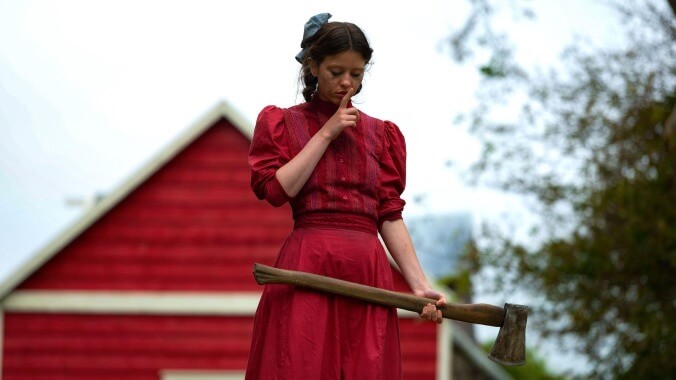How X and Pearl made slasher movies uncomfortable again
With their revolutionary approach, Ti West and Mia Goth have hacked away the nostalgia and given the genre a much-needed makeover

When it comes to horror there’s a certain obsession with revisiting the stylistic choices of the past, particularly the ’70s and ’80s, when so many of the movies that became foundational entries for horror fans were released into the canon. As much as the genre is constantly pushing forward, it also reaches back, with neon lights, synth scores, rock ballads, and John Hughes-inspired characters—and the success of Stranger Things, It (2017), and Grady Hendrix’s novel My Best Friend’s Exorcism suggests they speak to something viewers crave.
But using the past to subvert familiarity and create discomfort feels revolutionary in 2022, and revolution is exactly what filmmakers Ti West and Mia Goth have achieved with X and Pearl, companion films released six months apart by studio of the moment A24. While both films use slasher conventions to examine the moral history of America and remind audiences of truths they have forgotten, they also manage to provide a long-overdue update for the slasher genre.
Of course, slashers have always dealt with morality. From Alfred Hitchcock’s groundbreaking Psycho (1960) to the ’80s heyday that followed in the wake of Bob Clark’s Black Christmas (1974) and John Carpenter’s Halloween (1978), the subgenre has always taken a hard (if largely hypocritical) moral stance where perversion and sexuality invite mortal punishment.
Breaking all the rules
Whether intentional or not, the rules to surviving a slasher movie, outlined in Wes Craven’s Scream (1996), speak to thinly veiled racist and misogynistic values of Reagan-era politics and Satanic Panic fear-mongering ginned up by parents’ groups. West successfully evoked this familiar sensation with his slasher-adjacent breakthrough The House Of The Devil (2009). But X, set in 1978, isn’t interested in telling us what we already know or depicting a reality as seen through a former administration.
While X’s location and dusty aesthetic evoked immediate comparisons to Tobe Hooper’s The Texas Chain Saw Massacre (1974), the film is more concerned with invitation than transgression. West reimagines morally bankrupt porn stars, sleazy producers, and a generally filthy and cynical ’70s landscape, instead introducing audiences to a group of ambitious young filmmakers who just happen to make porn.
It’s a pro-sex take, but also a pro-filmmaking one, where Maxine (Mia Goth), Wayne (Martin Henderson), Bobby-Lynne (Brittany Snow), Jackson (Scott Mescudi), RJ (Owen Campbell) and Lorraine (Jenna Ortega) not only believe in what they’re doing but see what they do as a service, an exhibition, and a showcase of their youth. But when their hosts at the farmhouse where they’re filming envy and eventually resent that youth, the results are bloody—though also unexpectedly empathetic. West humanizes both the victims and killers in a way that highlights each individual’s longing to be seen. It’s a film honoring the forgotten and overlooked—whether they’re porn stars, the elderly, or even crew members on film sets.
What’s old is new
Metatextually, Pearl (Mia Goth) and Howard (Stephen Ure) are a physical manifestation of the notion of making the old new again. This idea has guided much of West’s filmography, including in his haunted hotel film, The Innkeepers (2011), his found-footage retelling of the Jonestown massacre in The Sacrament (2013), and the black-comedy western, In A Valley Of Violence (2016).
For West, age masks more interesting realities that challenge our pop culture-influenced ideas about past decades, the people who occupied them, and the values and perceptions that shaped their choices. Maxine stirs something in Pearl—not simply lust, but the reminder of being on the cusp of something, of a sense of hope for the unlimited possibilities life has to offer. The prequel to X, co-written by Goth, adds further context to Pearl’s desires, literally making the old new again, a point further driven home by the film’s release just a few months later, which makes them (and their forthcoming third installment) feel even more connected and cohesive.
Pearl deals with the idea of masks more directly. The film, which takes place in 1918, amid the Spanish flu and first World War, offers up an aesthetic of idealized Americana—friendly, hardworking farm people, war heroes, Douglas Sirk-inspired technicolor, and the musical whimsy of The Wizard Of Oz (1939). But just like Pearl’s innocent demeanor, this carefully curated pop culture backdrop begins to sour as the film progresses.
Douglas Sirk never went there
Cruelty, poverty, and fear of a pandemic strip away America’s idyllic possibilities; as an audience, we’re made aware of certain realities that Sirk’s films would never depict on screen—a pandemic in which masks obscure faces, the hopelessness of women relegated to domesticity, and a maddening isolation offset only by dreams of sex and success (“becoming a star”). Where X highlighted the hidden beauties of the ’70s, Pearl holds a microscope up to the ugliness of the 1910s, reminding viewers that a century venerated for its cultural growth too frequently achieved progress through blood, violence, and sickness.
X and Pearl serve as a game of tug of war between what audiences expect from horror movies set in the past, both satisfying and challenging their desire to see something new. These are films that will certainly remind you of others, yet using those references and influences purposely undermines nostalgia instead of simply wrapping us in its embrace.
With MaxXxine, the recently announced third film in West and Goth’s collaboration, the filmmakers will presumably take the opportunity to break conventions associated with the ’80s and further challenge our collective memories of the past, including the parts we’ve chosen to overlook for the sake of our own comfort. Ti West and Mia Goth have not only made slashers uncomfortable again, but have modernized slasher franchises by making each entry unique—not simply cobbling together entries from the carcasses of their forebears, but sorting through the viscera of filmmaking and history itself for something that cuts significantly deeper.